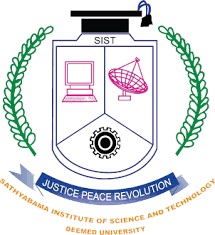
| Institute | Sathyabama Institute of Science and Technology |
| Exam | Sathyabama All India Online Entrance Exam [SAEEE] |
| Download | SAEEE Syllabus 2021 |
| Document Type | |
| Official Website | https://www.sathyabama.ac.in/ |
Sathyabama Entrance Exam [SAEEE] 2021
Sathyabama Institute of Science and Technology aims to provide higher education with high quality teaching and research.
Also Read : Sathyabama SAEEE 2021 Sample Question Paper
Download SAEEE 2021 Syllabus
| Subject | Syllabus |
| Maths |
Download |
| Physics | Download |
| Chemistry | Download |
SAEEE Physics Syllabus 2021
Unit 1: Physics And Measurement
Physics, technology and society, S I units, Fundamental and derived units. Least count, accuracy and precision of measuring instruments, Errors in measurement, Significant figures. Dimensions of Physical quantities, dimensional analysis and its applications.
Unit 2: Kinematics
Frame of reference. Motion in a straight line: Position time graph, speed and velocity. Uniform and non uniform motion, average speed and instantaneous velocity Uniformly accelerated motion, velocity-time, position-time graphs, relations for uniformly accelerated motion. Scalars and Vectors, Vector addition and Subtraction, Zero Vector, Scalar and Vector products, Unit Vector, Resolution of a Vector. Relative Velocity, Motion in a plane, Projectile Motion, Uniform Circular Motion.
Unit 3: Laws Of Motion
Force and Inertia, Newton’s First Law of motion; Momentum, Newton’s Second Law of motion; Impulse; Newton’s Third Law of motion. Law of conservation of linear omentum and its applications, Equilibrium of concurrent forces. Static and Kinetic friction, laws of friction, rolling friction. Dynamics of uniform circular motion: Centripetal force and its applications.
Unit 4: Work, Energy And Power
Work done by a constant force and a variable force; kinetic and potential energies, workenergy theorem, power. Potential energy of a spring, conservation of mechanical energy, conservative and nonconservative forces; Elastic and inelastic collisions in one and two dimensions.
Unit 5: Rotational Motion
Centre of mass of a two-particle system, Centre of mass of a rigid body; Basic concepts of rotational motion; Moment of a force, torque, angular momentum, conservation of angular momentum and its applications; moment of inertia, radius of gyration. Values of moments of inertia for simple geometrical objects, parallel and perpendicular axes theorems and their applications. Rigid body rotation, equations of rotational motion.
SAEEE Chemistry Syllabus 2021
Unit 1: Some Basic Concepts In Chemistry
Matter and its nature, Dalton’s atomic theory; Concept of atom, molecule, element and compound; Physical quantities and their measurements in Chemistry, precision and accuracy, significant figures, S.I. Units, dimensional analysis; Laws of chemical combination; Atomic and molecular masses, mole concept, molar mass, percentage composition, empirical and molecular formulae; Chemical equations and stoichiometry.
Unit 2: States Of Matter
Classification of matter into solid, liquid and gaseous states.
Gaseous State:
Measurable properties of gases; Gas laws – Boyle’s law, Charle’s law, Graham’s law of diffusion, Avogadro’s law, Dalton’s law of partial pressure; Concept of Absolute scale of temperature; Ideal gas equation; Kinetic theory of gases (only postulates); Concept of average, root mean square and most probable velocities; Real gases, deviation from Ideal behaviour, compressibility factor, van der Waals equation, liquefaction of gases, critical constants.
Liquid State:
Properties of liquids – vapour pressure, viscosity and surface tension and effect of temperature on them (qualitative treatment only).
Solid State:
Classification of solids: molecular, ionic, covalent and metallic solids, amorphous and crystalline solids (elementary idea); Bragg’s Law and its applications; Unit cell and lattices, packing in solids (fcc, bcc and hcp lattices), voids, calculations involving unit cell parameters, imperfection in solids; Electrical, magnetic and dielectric properties.
Unit 3 :Atomic Structure
Discovery of sub-atomic particles (electron, proton and neutron); Thomson and Rutherford atomic models and their limitations; Nature of electromagnetic radiation, photoelectric effect; Spectrum of hydrogen atom, Bohr model of hydrogen atom – its postulates, derivation of the relations for energy of the electron and radii of the different orbits, limitations of Bohr’s model; Dual nature of matter, de-Broglie’s relationship, Heisenberg uncertainty principle. Elementary ideas of quantum mechanics, quantum mechanical model of atom, its important features, and concept of atomic orbitals as one electron wave functions; Variation of and with r for 1s and 2s orbitals; various quantum numbers (principal, angular momentum and magnetic quantum numbers) and their significance; shapes of s, p and d – orbitals, electron spin and spin quantum number; Rules for filling electrons in orbitals aufbau principle, Pauli’s exclusion principle and Hund’s rule, electronic configuration of elements, extra stability of half-filled and completely filled orbitals.
Unit 4: Chemical Bonding And Molecular Strucure
Kossel – Lewis approach to chemical bond formation, concept of ionic and covalent onds.
Ionic Bonding:
Formation of ionic bonds, factors affecting the formation of ionic bonds; calculation of lattice enthalpy.
Covalent Bonding:
Concept of electronegativity, Fajan’s rule, dipole moment; Valence Shell Electron Pair Repulsion (VSEPR) theory and shapes of simple molecules.
Quantum mechanical approach to covalent bonding:
Valence bond theory – Its important features, concept of hybridization involving s, p and d orbitals; Resonance.
Molecular Orbital Theory – Its important features, LCAOs, types of molecular orbitals (bonding, antibonding), sigma and pi-bonds, molecular orbital electronic configurations of homonuclear diatomic molecules, concept of bond order, bond length and bond energy. Elementary idea of metallic bonding. Hydrogen bonding and its applications.
Unit 5 : Chemical Thermodynamics
Fundamentals of thermodynamics: System and surroundings, extensive and intensive properties, state functions, types of processes. First law of thermodynamics – Concept of work, heat internal energy and enthalpy, heat capacity, molar heat capacity; Hess’s law of constant heat summation; Enthalpies of bond dissociation, combustion, formation, atomization, sublimation, phase transition, hydration, ionization and solution. Second law of thermodynamics; Spontaneity of processes; DS of the universe and G of the system as criteria for spontaneity, Dgo (Standard Gibbs energy change) and quilibrium constant.
SAEEE Maths Syllabus 2021
Unit 1 : Sets, Relations And Functions
Sets and their representation; Union, Intersection and Complement of sets and their algebraic properties; Power set; Relation, Types of relations, Equivalence relations, functions; one-one, into and onto functions, composition of functions.
Unit 2 :Complex Numbers And Quadratic Equations
Complex numbers as ordered pairs of reals, Representation of complex numbers in the form a+ib and their representation in a plane, Argand diagram, Algebra of complex numbers, Modulus and Argument (or Amplitude) of a complex number, square root of a complex number, triangle inequality, Quadratic equations in real and complex number system and their solutions. Relation between roots and coefficients, nature of roots, formation of quadratic equations with given roots.
Unit 3 :Matrices And Determinants
Matrices, Algebra of matrices, Types of matrices, Determinants and matrices of order two and three. Properties of determinants, Evaluation of determinants, Area of triangles using determinants. Adjoint and evaluation of inverse of a square matrix using determinants and elementary transformations, Test of consistency and solution of simultaneous linear equations in two or three variables using determinants and matrices.
Unit 4 :Permutations And Combinations
Fundamental principle of counting, permutation as an arrangement and combination as selection, Meaning of P (n,r) and C (n,r), simple applications.
Unit 5 :Mathematical Induction
Principle of Mathematical Induction and its simple applications.
Have a question? Please feel free to reach out by leaving a comment below
![NTC All India Talent Search Exam [AITSE] Syllabus NTC-Logo](https://www.recruitmentzones.in/wp-content/uploads/2023/09/NTC-Logo-149x150.jpg)
![All India Scholarship Test Foundation [AISTF] UG-Medical 2023 Exam Syllabus AISTF-Logo](https://www.recruitmentzones.in/wp-content/uploads/2023/10/AISTF-Logo-150x150.jpg)

![NISER National Entrance Screening Test [NEST] 2021 Syllabus NEST-Logo](https://www.recruitmentzones.in/wp-content/uploads/2021/07/NEST-Logo-150x150.jpg)
![NICE Foundation National Scholarship Exam [NSE] 2021 Syllabus Nice-Foundation-Logo](https://www.recruitmentzones.in/wp-content/uploads/2021/09/Nice-Foundation-Logo-150x145.jpg)
![FIITJEE Talent Reward Exam [FTRE] 2021 Syllabus Syllabi FIITJEE](https://www.recruitmentzones.in/wp-content/uploads/2021/03/FIITJEE-Logo-150x105.png)